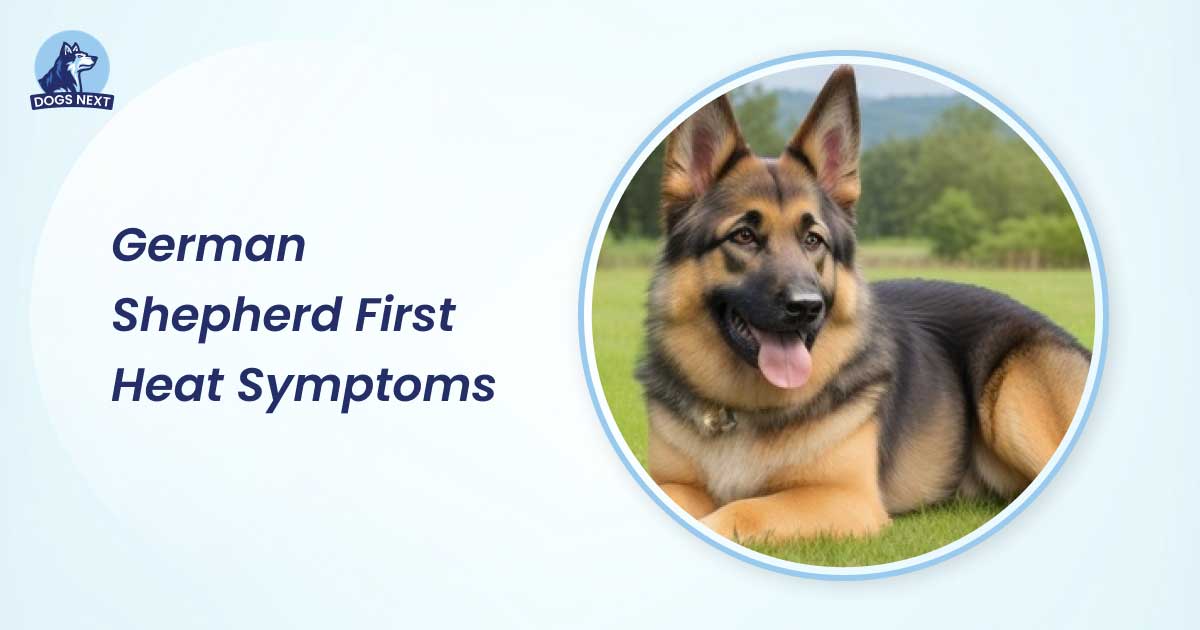German Shepherds show their first heat symptoms around six to twelve months old. Common signs include swelling of the vulva and increased urination.
German Shepherds experience their first heat cycle between six to twelve months of age. This natural process indicates the onset of sexual maturity in female dogs. Owners often notice swelling of the vulva, frequent urination, and a change in behavior.
Some dogs become more affectionate, while others may appear restless. Light bleeding or discharge is also common during this time. It’s crucial to monitor your dog closely and provide extra care and attention. Understanding these symptoms helps in managing your dog’s health and planning for future breeding or spaying decisions. Being aware of these signs ensures a smoother experience for both the pet and the owner.
Signs And Symptoms Of First Heat
When your German Shepherd experiences her first heat, it can be a confusing time for both of you. Knowing the signs and symptoms can help you navigate this phase smoothly. Understanding these symptoms will allow you to provide the best care for your furry friend.
Swelling Of The Vulva
One of the first signs of heat in German Shepherds is the swelling of the vulva. This physical change is usually easy to notice. The vulva becomes enlarged and more prominent. This swelling is a clear indicator that your dog is entering her heat cycle.
Other symptoms that may accompany vulva swelling include:
- Frequent urination
- Increased interest from male dogs
- Heightened self-cleaning behavior
A table to summarize these signs might look like this:
| Symptom | Description |
| Swelling of the Vulva | Vulva becomes larger and more noticeable |
| Frequent Urination | Your dog may urinate more often |
| Increased Male Interest | Male dogs show more interest in your dog |
Behavioral Changes
Behavioral changes are another key symptom of your German Shepherd’s first heat. You might notice restlessness and mood swings. These changes can affect her daily activities and interactions with you.
Common behavioral changes include:
- Increased clinginess
- Sudden aloofness
- Restlessness
- Frequent whining
Understanding these behaviors can help you provide better care and comfort for your dog. Create a comfortable space for her and keep an eye on her mood swings. This will help you manage her emotional needs during this phase.
Blood Discharge And Increased Licking
Another notable symptom is blood discharge. This discharge can vary in color from light pink to deep red. It is a natural part of the heat cycle. You might also notice your dog licking herself more frequently to clean the discharge.
To manage this symptom, consider the following:
- Use doggy diapers to keep your home clean
- Provide clean and comfortable bedding
- Monitor her licking to ensure she is not overdoing it
Here’s a quick overview of these signs:
| Symptom | Description |
| Blood Discharge | Varies in color from light pink to deep red |
| Increased Licking | Your dog cleans herself more frequently |
By keeping an eye on these signs and symptoms, you can ensure your German Shepherd’s first heat is a smooth experience for both of you.
How Long The Heat Cycle Lasts
Understanding the first heat symptoms in a German Shepherd is crucial for any dog owner. Knowing how long the heat cycle lasts can help you prepare and care for your pet. The heat cycle in German Shepherds is a natural process, but it can be confusing. Let’s break down the stages and duration of the heat cycle.
Different Stages Of The Heat Cycle
The heat cycle in German Shepherds comprises four main stages. Each stage has unique symptoms and behaviors:
- Proestrus: This is the beginning of the heat cycle. It lasts about 9 days. You’ll notice swelling in the vulva and a bloody discharge.
- Estrus: This stage lasts about 9 days too. The discharge becomes lighter, and your dog may seem more affectionate. This is the fertile period.
- Diestrus: This stage can last from 60 to 90 days. The symptoms of heat start to fade. If your dog is pregnant, this is when pregnancy develops.
- Anestrus: This is a resting phase and can last about 4 to 5 months. There’s no sexual activity during this time.
Here’s a table summarizing the stages of the heat cycle:
| Stage | Duration | Symptoms |
| Proestrus | 9 days | Swollen vulva, bloody discharge |
| Estrus | 9 days | Lighter discharge, affectionate behavior |
| Diestrus | 60-90 days | Fading heat symptoms |
| Anestrus | 4-5 months | No sexual activity |
Duration Of Each Stage
The duration of each stage in the heat cycle can vary. Generally, the entire cycle lasts about 6 months. Knowing the duration helps you understand your dog’s needs better.
Proestrus usually lasts around 9 days. During this time, you’ll see clear signs of the heat cycle starting. The dog’s vulva swells, and there’s a bloody discharge. It’s important to keep an eye on your dog during this stage.
Estrus also lasts about 9 days. This is the stage where your dog is most fertile. The discharge lightens, and your dog may become more affectionate. This is the time to be extra cautious if you don’t want your dog to mate.
Diestrus can last from 60 to 90 days. During this stage, the heat symptoms gradually disappear. If your dog is pregnant, this is when the pregnancy develops. Monitor your dog’s health closely during this period.
Anestrus is the resting phase and can last from 4 to 5 months. There’s no sexual activity during this time. It’s a good period for your dog to rest and recover.
Understanding the duration of each stage will help you provide the best care for your German Shepherd. It’s essential to be prepared and know what to expect.
How To Care For Your German Shepherd During Heat
German Shepherds are known for their intelligence and loyalty. When your German Shepherd experiences her first heat, it can be a challenging time for both of you. Understanding the symptoms and providing the right care can make this period smoother. Learn how to care for your German Shepherd during her heat cycle to ensure her comfort and well-being.
Hygiene And Managing Discharge
During heat, your German Shepherd may have a bloody discharge. Maintaining hygiene is crucial to prevent infections and keep her comfortable. Here are some tips:
- Use doggy diapers: These can help manage the discharge and keep your home clean.
- Regular cleaning: Clean the area around her vulva with a damp cloth daily.
- Bedding: Change her bedding frequently to avoid any odor and discomfort.
It’s important to monitor the discharge. If you notice any foul smell or unusual color, consult your vet. Keeping your German Shepherd clean helps her feel more comfortable and prevents any skin irritations or infections.
Exercise And Activity Levels During Heat
Exercise is important, but your German Shepherd might be more tired than usual during her heat. Adjust her activity levels accordingly:
- Shorter walks: Opt for shorter, more frequent walks instead of long ones.
- Safe play areas: Keep her in a safe, enclosed area to avoid unwanted male dog attention.
- Avoid strenuous activities: Skip high-energy activities that may cause stress or injury.
Staying active helps maintain her physical health, but always observe her behavior. If she seems lethargic or unwilling to exercise, let her rest. Respecting her energy levels ensures she stays healthy and happy during her heat cycle.
Comfort And Behavioral Support
Your German Shepherd may display behavioral changes during heat, such as clinginess or irritability. Providing comfort and support can help:
- Extra attention: Spend more time with her to provide reassurance and comfort.
- Calm environment: Ensure her surroundings are quiet and stress-free.
- Comfort items: Give her favorite toys or blankets to help her feel secure.
Sometimes, dogs in heat may feel anxious or moody. Be patient and gentle with her. Offer soothing words and gentle petting to ease her stress. Understanding her emotional needs is as important as managing physical symptoms. This will help her get through the heat cycle with ease.
When To Consult A Veterinarian
The first heat cycle of a German Shepherd is a significant milestone. It’s important to know the symptoms and understand when to consult a veterinarian. Being prepared helps ensure your dog’s health and well-being.
Signs Of Complications Or Abnormal Symptoms
During the heat cycle, German Shepherds might show symptoms indicating complications. It’s crucial to watch for these signs:
- Excessive bleeding: Normal heat cycles involve some bleeding, but excessive bleeding can signal a problem.
- Discharge with a foul odor: A foul-smelling discharge might indicate an infection.
- Swelling or redness: Unusual swelling or redness can be a sign of inflammation or infection.
- Lethargy: If your dog appears unusually tired or weak, it could be a sign of illness.
- Vomiting or diarrhea: These symptoms are not typical and should be checked by a vet.
Here is a table summarizing normal versus abnormal symptoms:
| Normal Symptoms | Abnormal Symptoms |
| Light bleeding | Excessive bleeding |
| Clear discharge | Foul-smelling discharge |
| Minor swelling | Significant swelling or redness |
| Alert and active | Lethargy |
| Normal appetite | Vomiting or diarrhea |
If you notice any of these abnormal symptoms, contact your veterinarian immediately. Early detection can prevent serious health issues.
How To Prepare For Future Heat Cycles
Preparing for future heat cycles helps manage your German Shepherd’s health. Here are some steps to take:
- Track cycles: Keep a record of the dates and symptoms of each cycle. This helps predict future cycles.
- Provide a comfortable space: Ensure your dog has a quiet, comfortable place to rest during her heat cycle.
- Maintain hygiene: Regularly clean your dog’s bedding and monitor her for any signs of infection.
- Diet and exercise: Maintain a balanced diet and regular exercise routine to keep your dog healthy.
- Consult your vet: Regular check-ups with the vet ensure your dog’s reproductive health is monitored.
Here are some essential items to have on hand:
- Pet diapers
- Cleaning wipes
- Comfortable bedding
- Nutritious treats
- Record-keeping notebook
By taking these steps, you can ensure your German Shepherd’s heat cycles are manageable and stress-free. Regular vet visits and good hygiene practices are key to your dog’s health.
Frequently Asked Questions
What Are The First Heat Symptoms In German Shepherds?
The first heat symptoms in German Shepherds include swelling of the vulva, increased urination, and changes in behavior. You might also notice a bloody discharge. These signs typically appear around six months of age.
How Long Does A German Shepherd’s Heat Last?
A German Shepherd’s heat lasts about 2 to 4 weeks. During this period, keep an eye on her behavior and physical changes. Always consult your vet for specific advice.
When Do German Shepherds Have Their First Heat?
German Shepherds usually have their first heat around six to twelve months of age. However, it can vary among individual dogs. Monitoring your dog’s development is crucial.
Can Heat Affect My German Shepherd’s Behavior?
Yes, heat can affect your German Shepherd’s behavior. She may become more affectionate or irritable. Some dogs also display restlessness or anxiety. These changes are normal and temporary.
Conclusion
Recognizing your German Shepherd’s first heat symptoms is crucial for their health. Early detection ensures proper care. Pay attention to behavioral changes and physical signs. Consult your vet for guidance and support. Understanding these symptoms helps you provide the best care for your furry friend.
Stay informed and attentive to keep your dog happy and healthy.

I’m David, an expert contributor and writer, with two furry friends of my own, I know the challenges of raising and caring for dogs. From training to nutrition and health, my goal is to provide valuable insights and advice to help create strong bonds and happy, healthy lives. Find me in Twitter.




